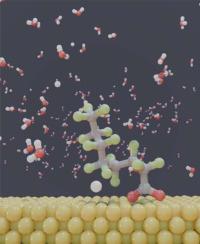Efficient degradation of per- and polyfluoroalkyl substances on plasmonic surfaces with visible light
IF 11.3
1区 环境科学与生态学
Q1 ENGINEERING, ENVIRONMENTAL
引用次数: 0
Abstract
Drinking water with per- and polyfluorosubstances (PFAS) contaminants poses serious public health risks, prompting intensive efforts to develop effective remediation strategies. Among these, photodegradation processes are particularly promising because of their efficiency and intrinsic environmental friendliness. However, the experimental identification of suitable photoactive materials and a detailed understanding of the underlying reaction mechanisms are challenging because of the inherent complexity of these excited-state processes. Using our recently developed real-time electron-nuclear dynamics approach (Xu et al., 2024), we demonstrate efficient photoinduced degradation of perfluorooctanoic acid (PFOA) on a plasmonic Au(111) surface with visible light at 530 nm. Our approach enables large-scale simulations (containing over 400 atoms) beyond conventional quantum calculations, which are required to capture the complex photo-induced degradation dynamics in realistic aqueous environments. In particular, our results highlight a complex interplay of collective excitations between the Au(111) surface and adsorbed PFOA molecule, where the surrounding water molecules play an active role in charge transfer that drives the degradation process. Our photo-induced dynamics approaches highlight the utility of plasmonic surfaces and water for efficient PFAS degradation; moreover, these predictive calculations can be used to prescreen candidate material surfaces, solvents, and photocatalytic conditions to remediate PFAS and other environmental contaminants.Environmental Implication: Our time-resolved electron-nuclear dynamics simulations reveal that the plasmonic Au(111) surface is an effective photoactive material that can enable PFOA degradation with visible light (530 nm). Moreover, our results surprisingly show that the surrounding water molecules are not merely spectators in the degradation process and actively participate to enhance charge transfer and promote PFOA decomposition.

用可见光有效降解等离子体表面上的全氟烷基和多氟烷基物质
含有单氟和多氟物质污染物的饮用水构成严重的公共健康风险,促使人们大力努力制定有效的补救战略。其中,光降解过程因其效率和内在的环境友好性而特别有前景。然而,由于这些激发态过程固有的复杂性,合适的光活性材料的实验鉴定和对潜在反应机制的详细了解是具有挑战性的。利用我们最近开发的实时电子-核动力学方法(Xu et al., 2024),我们展示了在530 nm可见光下等离子体Au(111)表面上全氟辛酸(PFOA)的有效光诱导降解。我们的方法使大规模模拟(包含超过400个原子)超越了传统的量子计算,这需要在现实的水环境中捕获复杂的光诱导降解动力学。特别是,我们的研究结果强调了Au(111)表面和吸附的PFOA分子之间的集体激发的复杂相互作用,其中周围的水分子在驱动降解过程的电荷转移中起着积极的作用。我们的光诱导动力学方法强调了等离子体表面和水对PFAS有效降解的效用;此外,这些预测计算可用于预筛选候选材料表面、溶剂和光催化条件,以修复PFAS和其他环境污染物。环境意义:我们的时间分辨电子-核动力学模拟表明,等离子体Au(111)表面是一种有效的光活性材料,可以在可见光(530 nm)下降解PFOA。此外,我们的研究结果令人惊讶地表明,在降解过程中,周围的水分子不仅仅是旁观者,而是积极参与增强电荷转移,促进PFOA分解。
本文章由计算机程序翻译,如有差异,请以英文原文为准。
求助全文
约1分钟内获得全文
求助全文
来源期刊

Journal of Hazardous Materials
工程技术-工程:环境
CiteScore
25.40
自引率
5.90%
发文量
3059
审稿时长
58 days
期刊介绍:
The Journal of Hazardous Materials serves as a global platform for promoting cutting-edge research in the field of Environmental Science and Engineering. Our publication features a wide range of articles, including full-length research papers, review articles, and perspectives, with the aim of enhancing our understanding of the dangers and risks associated with various materials concerning public health and the environment. It is important to note that the term "environmental contaminants" refers specifically to substances that pose hazardous effects through contamination, while excluding those that do not have such impacts on the environment or human health. Moreover, we emphasize the distinction between wastes and hazardous materials in order to provide further clarity on the scope of the journal. We have a keen interest in exploring specific compounds and microbial agents that have adverse effects on the environment.
 求助内容:
求助内容: 应助结果提醒方式:
应助结果提醒方式:


